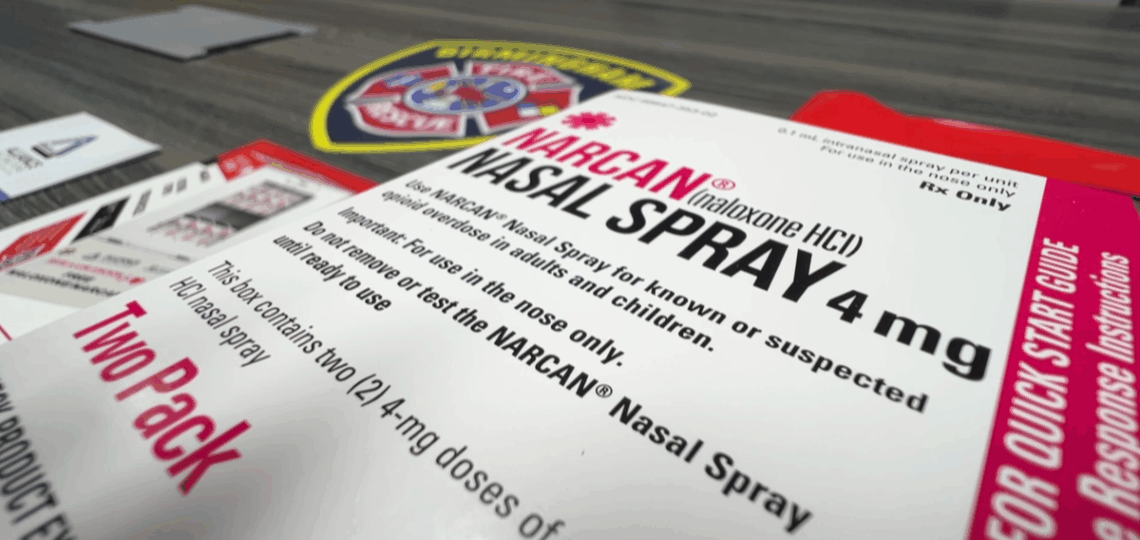
As overdose deaths fall, Trump administration proposes cuts to lifesaving Narcan program
The Trump administration has proposed cutting a $56 million grant that teaches first responders how to use the lifesaving overdose reversal drug naloxone, which experts say could reverse progress the United States has made in lowering opioid overdose deaths.
A recent dip in overdose deaths has been credited in part to wider naloxone access. The medication was made available for over-the-counter purchase in 2023 and is standard for first responders to carry. It’s even popped up in some classrooms.
Naloxone, also sold under the brand name Narcan, is available in injectable and nasal spray form. It is an opioid antagonist that attaches to receptors in the brain, reversing and blocking the effects of other opioids, including fentanyl.
The grant money can be used by state and local organizations for training people on how to use naloxone, as well as administering and distributing the medication. Grantees are expected to establish protocols to refer patients to treatment or support services and provide other safety information about illicit drugs and overdoses. The grant is administered by the Substance Abuse and Mental Health Services Administration.
“While some skeptics may think that naloxone – and harm reduction more generally – enable people, there is decades of research that show giving people the information and tools they need helps keep people safe,” medical anthropologist Jennifer Syvertsen said in an emailed statement. “Naloxone simply enables people to breathe.”
Wider cuts could “dismantle essential services”
The proposed cut comes as the Trump administration proposes cutting $33.3 billion from the Health and Human Services budget in 2026, according to the Associated Press. The cuts would eliminate SAMHSA, the AP reported in March.
Health Secretary Robert F. Kennedy Jr., who referenced his history of heroin addiction during his confirmation hearings, has proposed that the administration be absorbed into a new office. HHS has also faced mass layoffs.
These combined cuts could “dismantle essential services,” Hanna Sharif-Kazemi, the federal policy manager for the Drug Policy Alliance, told CBS News. The DPA is a non-profit agency based in New York City that seeks to reduce overdose deaths with harm reduction and evidence-based methodology.
“We believe it’s going to exacerbate the overdose crisis at a time when nearly 90,000 people died from overdoses last year,” Sharif-Kazemi said.
The loss of federal funding, Sharif-Kazemi said, can exacerbate the budget issues that state and local agencies already face.
“Without federal funding, states may be forced to reduce essential services in other sectors, like health care, education and public safety, or they would fail to compensate for the loss in overdose prevention funding, which would put more lives at risk,” Sharif-Kazemi said. “Those cuts to overdose prevention programs are going to undermine proven strategies that we know save lives.”
How can the federal government support overdose prevention efforts?
During his second term, Mr. Trump has focused on fentanyl entering the United States. He has enacted tariffs on China, Canada and Mexico with the goal of making the countries fight fentanyl trafficking. Little fentanyl enters the U.S. over the northern border. Precursor chemicals, or the ingredients for fentanyl and other illicit drugs, are largely manufactured in China and shipped overseas, usually to Mexico. The fentanyl is then produced, typically in Mexico, and brought to the United States for distribution.
Sharif-Kazemi said the best way to build on the progress made in reducing overdose deaths is to continue and even expand federal funding for overdose prevention efforts. That could include expanded access to naloxone, she said, as well as better access to medication-assisted treatment, which Trump has previously pushed for, and the expansion of rehabilitation facilities. It could also include more funding for harm reduction strategies, like testing strips that allow people to check if drugs are contaminated with fentanyl.
Recent years have also seen a push for overdose prevention centers, where people who use drugs can do so under the supervision of trained medical professionals. Those medical professionals can then monitor the drug users, and administer naloxone or other medications if necessary. OnPoint NYC operates two such sites in New York City. The organization said in January that its staff have reversed over 1,700 opioid overdoses since November 2021.
“We know the 90,000 people that we lost to overdose last year were denied the care and support they needed,” Sharif-Kazemi said. “These are all tools that we know actually can save people’s lives. Ultimately, if the Trump administration was really worried about making sure that people entered recovery, we need to make sure they stay alive and are able to actually enter recovery.”